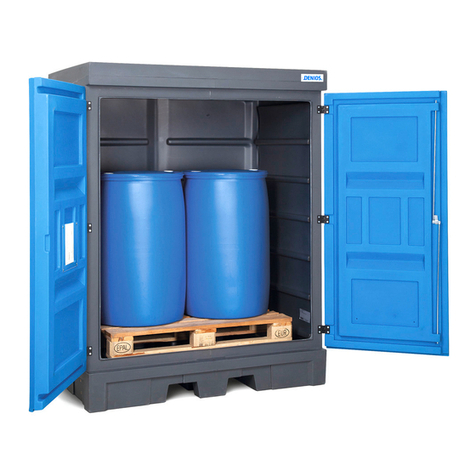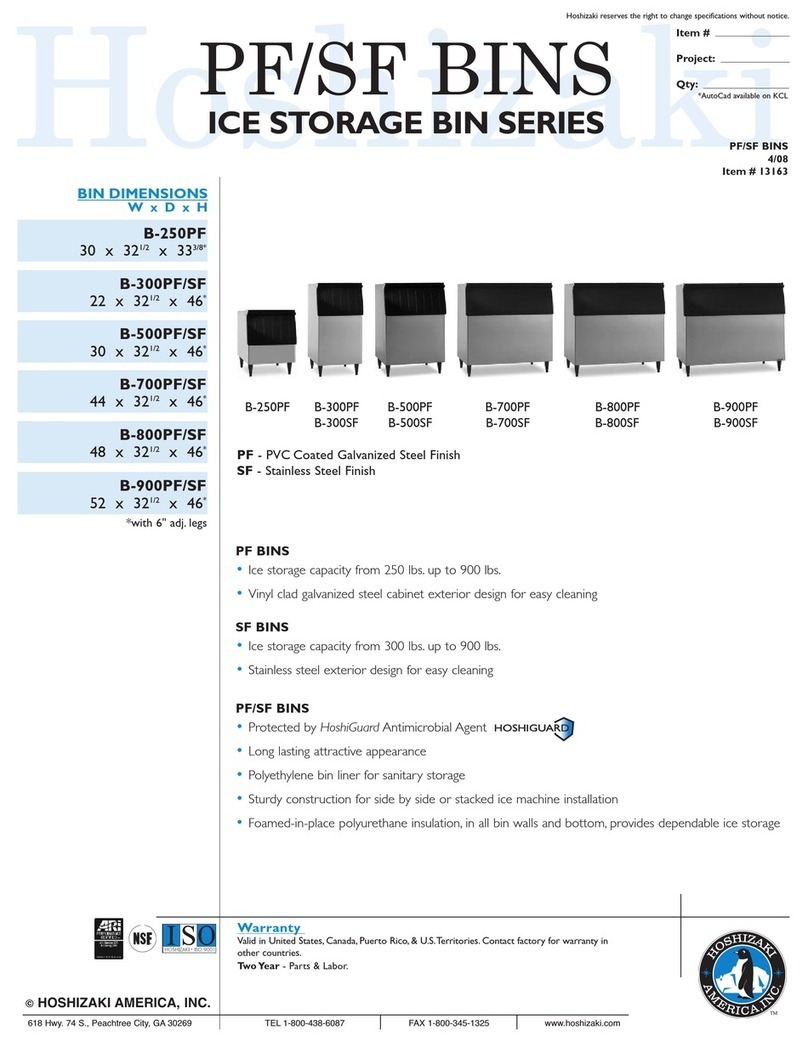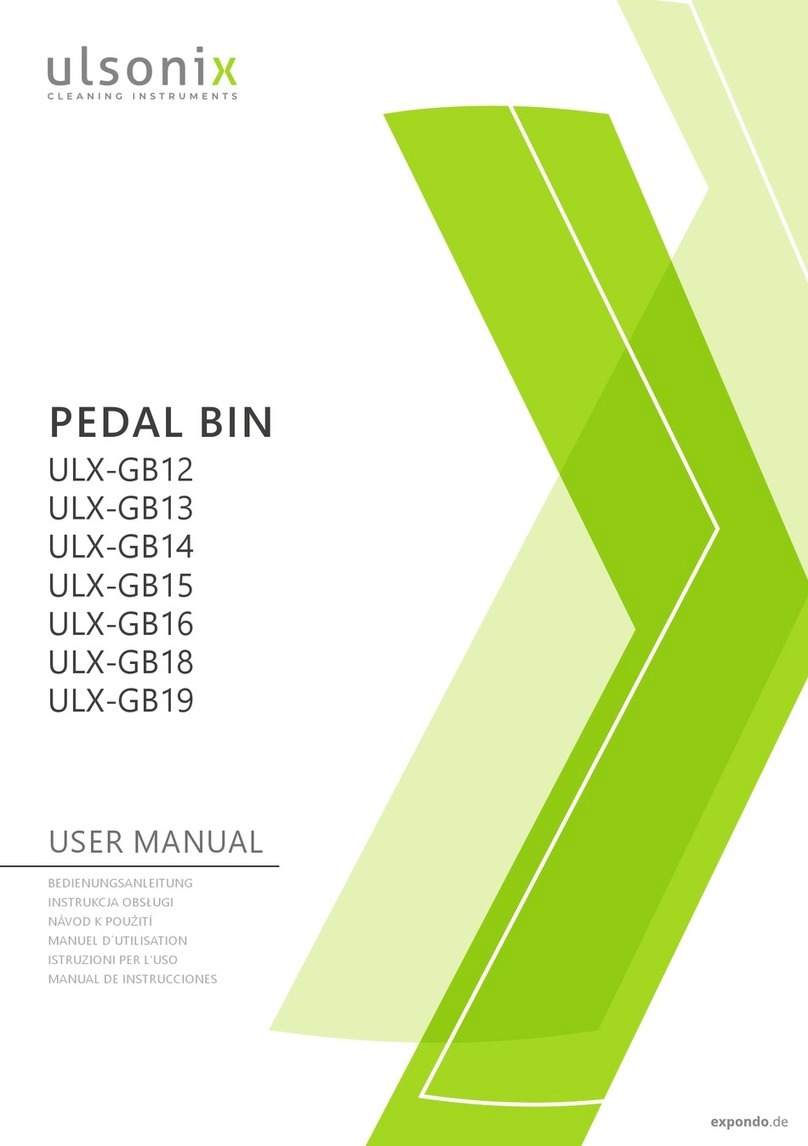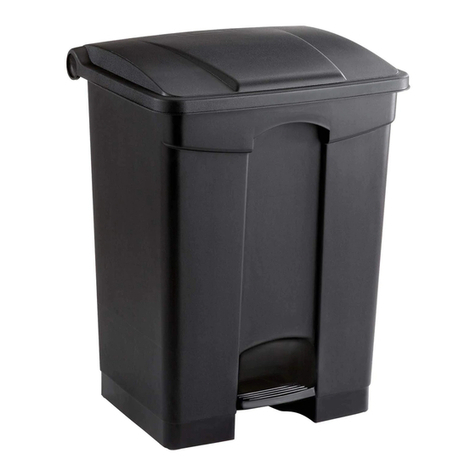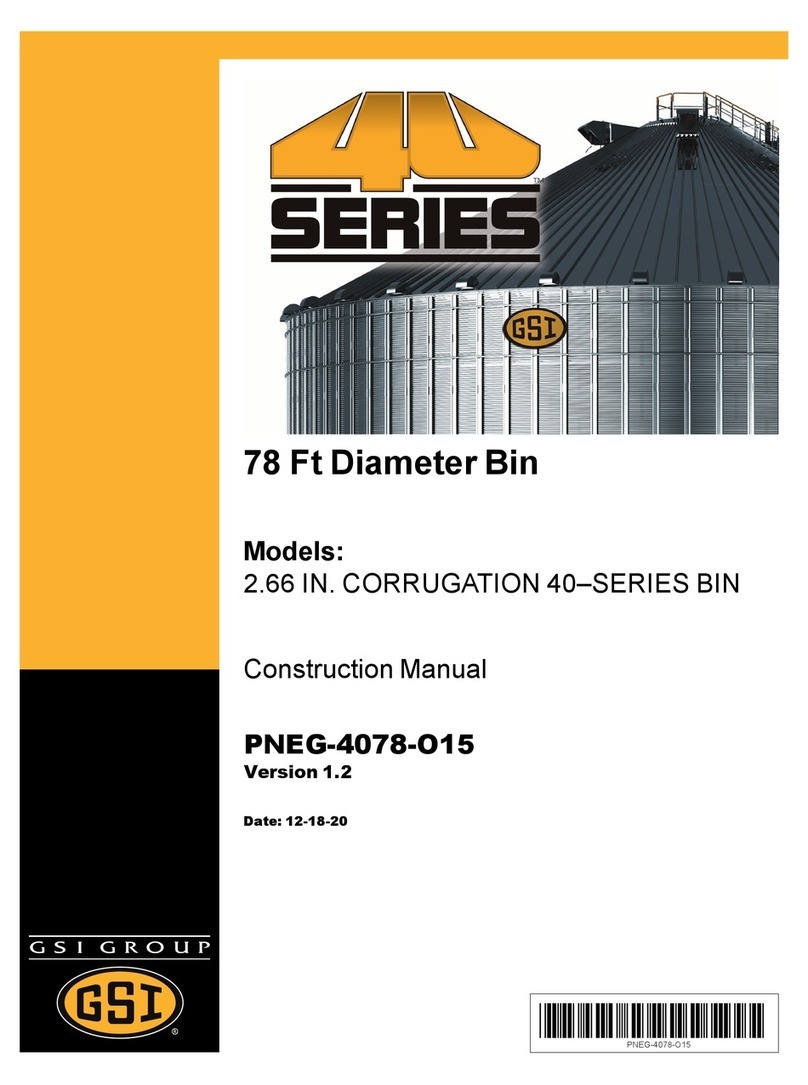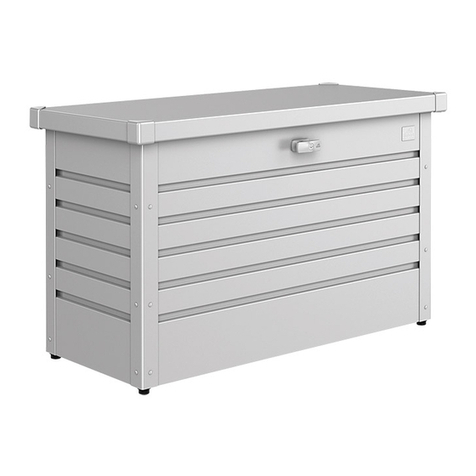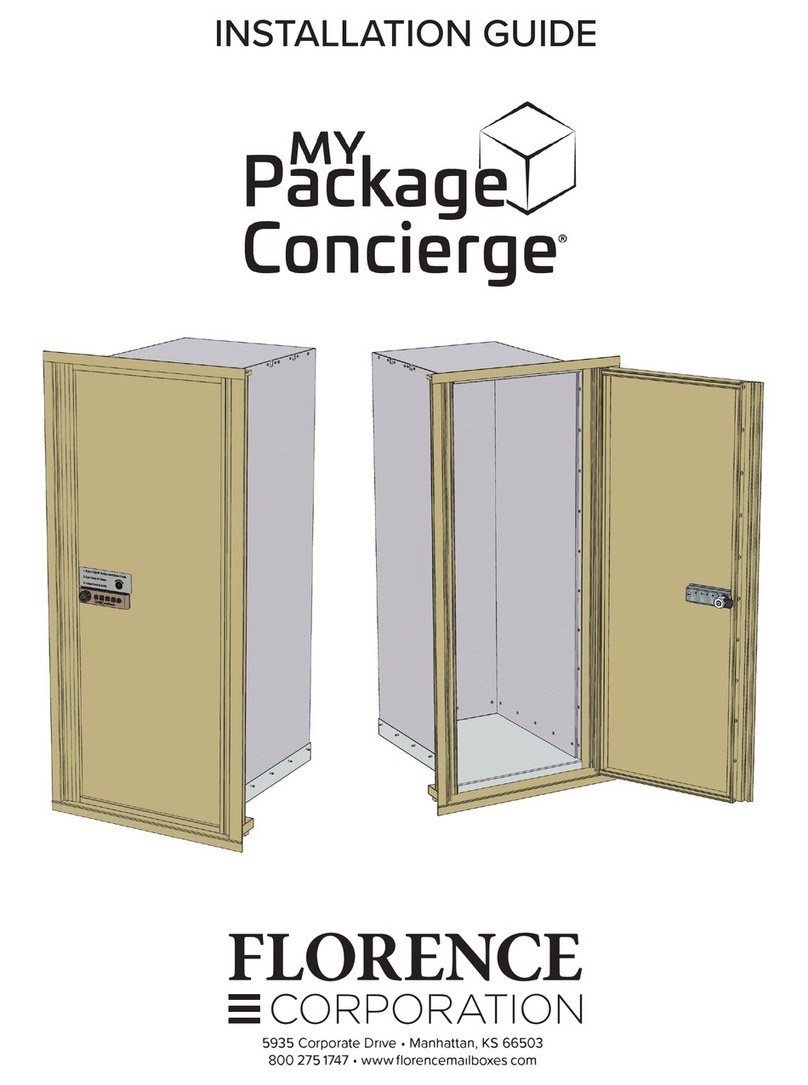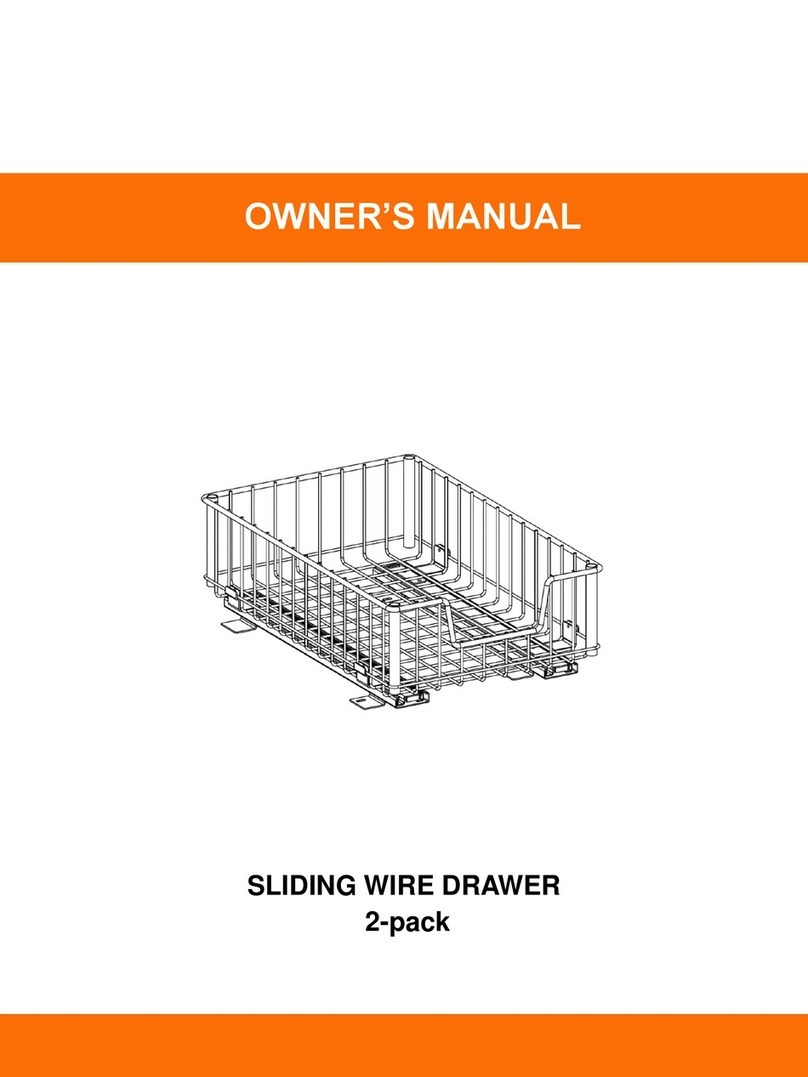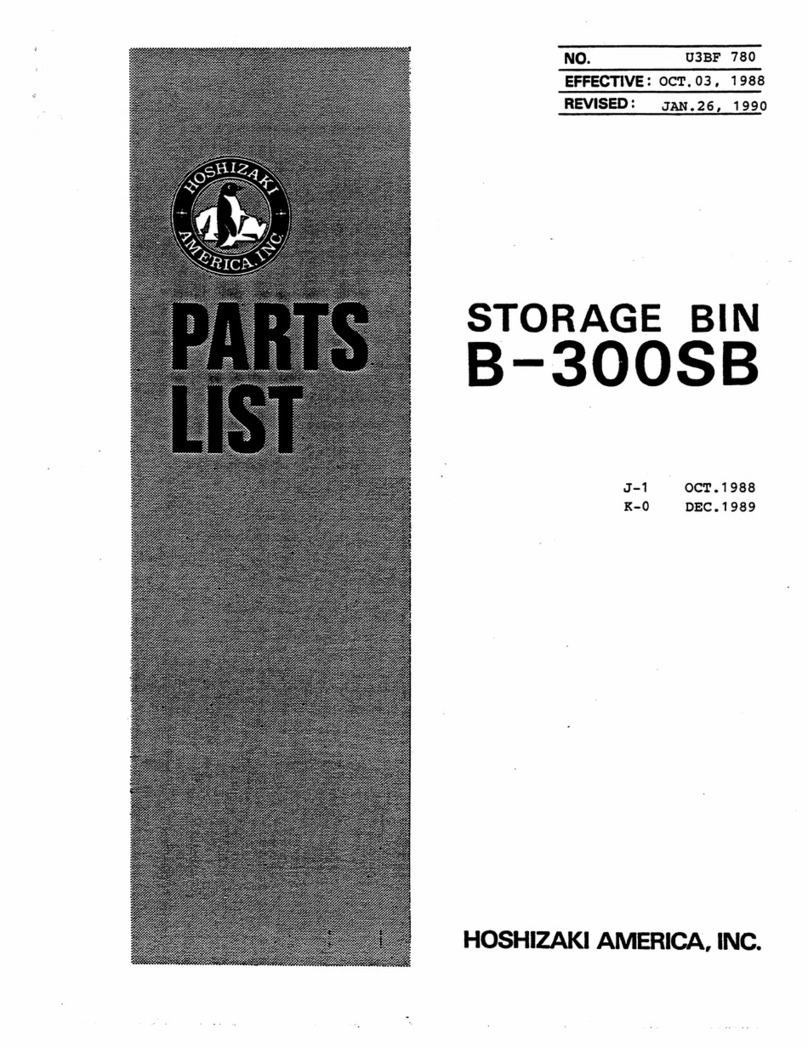Denios VarioTwin TW 62 User manual

Original
Betriebsanleitung
217882_BA_VarioTwin_001_INT
25.06.13
Betriebsanleitung
Auffangwannen Typ VarioTwin
Urheberrecht
Im Sinne des Gesetzes gegen unlauteren Wettbewerb ist diese Betriebsanleitung eine Urkunde.
Das Urheberrecht davon verbleibt der
DENIOS AG
Dehmer Str. 58-66
32549 Bad Oeynhausen
Tel.: +49 5731 753-0
Fax.: +49 5731 753-199
Diese Betriebsanleitung ist für den Betreiber des Lagersystems und dessen Personal bestimmt. Sie enthält
Texte, Bilder und Zeichnungen, die ohne ausdrückliche Genehmigung der DENIOS AG weder vollständig
noch teilweise
vervielfältigt,
verbreitet oder
anderweitig mitgeteilt werden dürfen.
© Copyright DENIOS AG 2013 Unterliegt nicht dem Änderungsdienst

Original
Betriebsanleitung
217882_BA_VarioTwin_001_INT
Seite 2 von 28 25.06.13
1Allgemeine Hinweise....................................................................................................................... 3
1.1 Bestimmungsgemäße Verwendung............................................................................................3
1.2 Fehlanwendungen ......................................................................................................................3
1.3 Mängelansprüche und Haftung...................................................................................................3
2Sicherheitshinweise ........................................................................................................................ 4
3Transport, Aufstellen und Montage.................................................................................................. 4
3.1 Transport durch Hebezeug .........................................................................................................4
3.2 Aufstellungsbedingungen............................................................................................................4
3.3 Montage der Gitterrosten (optional) ............................................................................................4
4Technische Daten ........................................................................................................................... 6
4.1 Abmessungen und Traglast ........................................................................................................6
5Betrieb ............................................................................................................................................ 6
5.1 Sicherheitshinweise ....................................................................................................................6
5.2 Bestücken der Auffangwanne .....................................................................................................6
6Wartung und Pflege ........................................................................................................................ 7
7Entsorgung ..................................................................................................................................... 7

Original
Betriebsanleitung
217882_BA_VarioTwin_001_INT
Seite 3 von 28 25.06.13
1Allgemeine Hinweise
Die Hinweise und Anweisungen dieser Betriebsanleitung sind einzuhalten und zu beachten. Jede Person,
die mit der Aufstellung, Bedienung, Wartung und Reparatur des Produktes befasst ist, muss die Betriebs-
anleitung gelesen und verstanden haben.
Gegenüber den Darstellungen und Angaben in der Betriebsanleitung sind technische Änderungen, die der
Verbesserung des Lagersystems dienen, vorbehalten.
HINWEIS
Die nationalen Vorschriften und Sicherheitsbestimmungen bezüglich Gefahrstoffen, Si-
cherheitsvorschriften, Betriebssicherheit und Betreiberpflichten beachten.
1.1 Bestimmungsgemäße Verwendung
Auffangwannen Typ VarioTwin sind zur Lagerung von wassergefährdenden Stoffen aller Wassergefähr-
dungsklassen WGK 1-3 nach WHG / VAUwS sowie entzündlichen, leicht- und hochentzündlichen Flüssig-
keiten der Klassen H224, H225, H226 geeignet. Verpackungen und Behälter müssen so beschaffen sein,
dass sie den verkehrsrechtlichen Vorschriften entsprechen.
Die Auffangwannen sind ausschließlich innerhalb der im Kapitel 4 „Technische Daten“ aufgeführten Leis-
tungsgrenzen zu verwenden.
1.2 Fehlanwendungen
Als Fehlanwendung gilt insbesondere:
Einlagern unzulässiger Stoffe: Die Beständigkeit des Wannenwerkstoffes gegenüber dem Lagerme-
dium muss nachgewiesen sein.
Das Einsetzen der Auffangwanne zu anderen, als in Kapitel 1.1 Bestimmungsgemäße Verwendung
aufgeführten Zwecken.
Einlagern unzulässiger Gebinde: Die Gebinde müssen den verkehrsrechtlichen Vorschriften für das
Befördern gefährlicher Güter entsprechen.
Zusammenlegungsverbot: Medien, die miteinander reagieren können, nicht über derselben Auf-
fangwanne lagern.
Überschreiten von Lagermenge und Tragfähigkeit.
1.3 Mängelansprüche und Haftung
Mängel- und Haftungsansprüche bei Personen- und Sachschäden sind ausgeschlossen, wenn sie auf eine
oder mehrere der folgenden Ursachen zurückzuführen sind:
Nicht bestimmungsgemäße Verwendung.
Unsachgemäßes Montieren, Bedienen und Warten.
Eigenmächtige bauliche Veränderungen.

Original
Betriebsanleitung
217882_BA_VarioTwin_001_INT
Seite 4 von 28 25.06.13
2Sicherheitshinweise
WARNUNG
Jede sicherheitsbedenkliche Arbeitsweise unterlassen.
Die geltenden Regeln für Sicherheit und Gesundheit bei der Arbeit beachten.
Feuer, offenes Licht sowie Rauchen verboten.
Verpackungen und Behälter müssen so beschaffen sein, dass sie den verkehrs-
rechtlichen Vorschriften entsprechen.
Nur Stoffe lagern, für die die Auffangwanne geeignet ist.
Tragkraft der Auffangwanne darf nicht überschritten werden.
Stoffe so lagern, dass alle Gebinde und die Auffangwanne einsehbar sind.
HINWEIS
Beim Einsatz von entzündbaren Stoffen ist vom Betreiber eine Risikobeurteilung, die
die Maßnahmen zur Abwendung von Gefahren gemäß der ATEX-Richtlinie festlegt, zu
erstellen.
3Transport, Aufstellen und Montage
3.1 Transport durch Hebezeug
Die Auffangwanne darf nur im unbeladenen Zustand transportiert werden.
Die Auffangwanne ist mit Gabelstapler oder Hubwagen vierseitig unterfahr- und transportierbar.
3.2 Aufstellungsbedingungen
Die Auffangwanne darf nur auf ebenen und befestigten Flächen aufgestellt werden. Die Auffangwanne ist
zur Verwendung in Gebäuden konzipiert. Bei Aufstellung im Freien ist diese so zu positionieren, dass Nie-
derschlagswasser nicht in oder unter die Auffangwanne gelangen kann.
3.3 Montage der Gitterrosten (optional)
Gitterrostauflagen einhängen, eventuell mit leichten Schlägen (Hammer / Gummihammer) auf den
Wannenrand treiben. Mittenauflage (wenn vorhanden) einlegen. Gitterroste auflegen. Dabei auf gleiche
Abstände der Gitterroste zum Wannenrand achten.
Bei Auffangwanne Typ TW 203-L und TW 208-L Gitterrosten bzw. Gitterrostunterstützung mit beigefüg-
ter Verschraubung befestigen.
(siehe Abb. 3.3.-1 bis 3.3.-3 - nächste Seite)

Original
Betriebsanleitung
217882_BA_VarioTwin_001_INT
Seite 5 von 28 25.06.13
Abb. 3.3-1: Auffangwanne Typ TW 204
Typ TW 62, TW 201, TW 202
und TW 204-L ohne Pos. c
Abb. 3.3-2: Auffangwanne Typ TW203-L
Querstrebe mittels Schraube,
Federring und Mutter verbinden
Abb. 3.3-3: Auffangwanne Typ TW208-L
Gitterroste mittels Giro-Befestigung
Teller und Bohrschraube auf Unter-
stützung befestigen
(1x je Gitterroste)
a
Pos.
Benennung
a
Gitterroste
b
Gitterrostauflagen
c
Gitterrostunterstützung
d
Querstrebe
e
Senkschraube M6x16
f
Federring
g
Sechskantmutter M6
h
Sechskantbohrschraube
6,3x50
i
Giro-Befestigung Teller
c
b
a
b
e
d
f
g
h
i
a
c
b

Original
Betriebsanleitung
217882_BA_VarioTwin_001_INT
Seite 6 von 28 25.06.13
4Technische Daten
Die Auffangwanne Typ VarioTwin besteht aus einer geschweißten Stahlauffangwanne mit Sockelfüßen
aus Kunststoff (PP). Die Auffangwanne ist verzinkt oder lackiert erhältlich.
Als Stellfläche dient ein Gitterrost (optional).
4.1 Abmessungen und Traglast
Typ
B (mm)
T (mm)
H (mm)
Max. Belastung
(kg/m²)
Auffangvolumen (l)
TW 62
785
635
283
850
60
TW 201
841
816
483
850
200
TW 202
1236
815
360
850
200
TW 204
1236
1210
295
850
200
TW 203-L
2005
815
360
850
335
TW 204-L
2470
816
253
850
220
TW 208-L
2455
1210
258
850
340
5Betrieb
5.1 Sicherheitshinweise
WARNUNG
Sicherheitshinweise beachten!
Die Sicherheitshinweise im Kapitel 2 "Sicherheitshinweise" beachten.
5.2 Beladen der Auffangwanne
Die Fässer mit geeigneten Hilfsmitteln auf die bzw. in der Auffangwanne Typ VarioTwin aufstellen.
Fässer auf sicheren Stand kontrollieren und gegen um- bzw. herabstürzen sichern!
Falls mehrere Behälter in die Auffangwanne gestellt werden, muss dieses bei der Berechnung des Auf-
fangvolumens der Auffangwanne mit einbezogen werden. Und zwar darf bei dem größten in ihr stehenden
Behälter der Rauminhalt bis zur zulässigen Füllhöhe der Auffangwanne einbezogen werden. Bei den ande-
ren Fässern wird der Rauminhalt bis zur zulässigen Füllhöhe der Auffangwanne abgezogen. Das so ermit-
telte Auffangvolumen muss den Inhalt des größten Behälters, mindestens 10 % des Gesamtinhaltes der in
ihr gelagerten Behältnisse aufnehmen können.
Bei Behältern, die zum Abfüllen verwendet werden (z.B. liegende Fässer mit Hahn), muss auch der Hand-
habungsbereich durch die Auffangwanne gesichert sein. Abfüllgefäße (z.B. Kannen) dürfen nicht über den
Wannenrand hinausragen.

Original
Betriebsanleitung
217882_BA_VarioTwin_001_INT
Seite 7 von 28 25.06.13
6Wartung und Pflege
Regelmäßige Pflege und Wartung verlängert die Lebensdauer der Auffangwanne Typ VarioTwin.
Sollten Beschädigungen an der Auffangwanne und/oder der Gitterroste auftreten, so sind diese unverzüg-
lich zu beseitigen.
Schäden am Oberflächenschutz der Auffangwanne sind umgehend vom Betreiber auszubessern, damit
keine Korrosion auftreten kann. Beim Austausch des Gitterrostes darf nur ein Gitterrost gleicher Tragkraft
und Abmessung verwendet werden.
Um die Wanne zu reinigen sind ggf. die Gitterrosten mit den Unterstützungen zu entfernen. Nach der Rei-
nigung müssen alle Unterstützungen und Gitterrosten wie im Kapitel 3.3 Montage der Gitterrosten wieder
eingebaut werden.
HINWEIS
Auffangwanne trocken und frei von Verschmutzungen halten
Auffangwanne wöchentlich, auch an der Unterseite, auf ausgelaufene Flüssigkeit
prüfen
Ausgelaufenen Flüssigkeit umgehend schadlos beseitigen
Nur Originalersatzteile des Herstellers verwenden
7Entsorgung
HINWEIS
Vor der Entsorgung ist die Auffangwanne gründlich von eventuellen Gefahrstoffrück-
ständen zu reinigen!
Die Auffangwanne besteht im Wesentlichen aus Metall- und Kunststoffteilen. Führen Sie die Entsorgung
dieser anfallenden Abfallstoffe, nach der Außerbetriebnahme der Wanne, entsprechend den regionalen
und gesetzlichen Bestimmungen durch.

Original
User Manual
217882_BA_VarioTwin_001_INT
25.06.13
User Manual
VarioTwin Sump
Copyright
In legal terms this User Manual is certification to counteract unfair competition.
Copyright is held by
DENIOS UK
Dehmer Straße 58-66
32549 Bad Oeynhausen
Tel.: +49 5731753-0
Fax: +49 5731753-199
This User Manual is intended for the operator of the storage system and its personnel. It contains texts,
images and drawings which need the express consent of DENIOS AG before they can be
reproduced,
distributed or
otherwise shared, either in full or in part.
© Copyright DENIOS AG 2013 Not subject to the revision service.

Original
User Manual
217882_BA_VarioTwin_001_INT
Page 9 of 28 25.06.13
Contents
1General Instructions ...................................................................................................................... 10
1.1 Intended use of the equipment .................................................................................................10
1.2 Misuse.......................................................................................................................................10
1.3 Claims for defects and liability ..................................................................................................10
2Safety instructions......................................................................................................................... 11
3Transport, placement and installation ............................................................................................ 11
3.1 Transport using lifting equipment..............................................................................................11
3.2 Conditions for placement ..........................................................................................................11
3.3 Fitting the grids (optional) .........................................................................................................11
4Technical data .............................................................................................................................. 13
4.1 Dimensions and load capacity ..................................................................................................13
5Operation...................................................................................................................................... 13
5.1 Safety instructions.....................................................................................................................13
5.2 Loading the sump .....................................................................................................................13
6Maintenance and care................................................................................................................... 14
7Disposal........................................................................................................................................ 14

Original
User Manual
217882_BA_VarioTwin_001_INT
Page 10 of 28 25.06.13
1 General Instructions
The instructions in this user manual must be carefully followed and adhered to. All those involved in the
installation, operation, maintenance and repair of the product must have read and understood this user
manual.
We reserve the right to make technical changes to the illustrations and details in the user manual in order
to improve the storage system.
NOTE
The national guidelines and safety regulations with respect to hazardous materials, safe-
ty regulations, occupational safety and operator duties must be observed.
1.1 Intended use of the equipment
VarioTwin sumps are suitable for the storage of water-polluting substances in all water-polluting classes
WGK 1-3 in accordance with WHG / VAUwS as well as flammable, highly flammable and extremely flam-
mable fluids in classes H224, H225 and H226. Packaging and containers must meet the transport regula-
tions.
The storage systems should be used exclusively within the performance parameters listed in 4
"Technische Daten".
1.2 Misuse
The following are considered as misuse:
Storage of inadmissible materials: The resistance of the sump material to the storage medium must
be demonstrated.
Use of the sump for purposes other than those specified in section 1.1 Bestimmungsgemäße Ver-
wendung .
Storage of inadmissible containers: Containers must comply with guidelines for the transport of haz-
ardous goods.
Unapproved combinations: Media which can react with one another may not be stored above the
same sump.
Exceeding storage quantity and load capacity.
1.3 Claims for defects and liability
We are not liable for claims for defects and liability for injury to persons or property caused by one or more
of the following:
Improper use of equipment
Incorrect installation, operation and maintenance.
Unapproved modifications.

Original
User Manual
217882_BA_VarioTwin_001_INT
Page 11 of 28 25.06.13
2Safety instructions
WARNING
Refrain from any unsafe working practices.
Observe the applicable rules for health and safety at work.
No fire, naked flames or smoking.
Packaging and containers must meet the transport regulations.
Only store materials for which the sump is designed.
Do not exceed the load capacity of the sump.
Store materials so that all containers and the sump are visible.
NOTE
If flammable substances are to be stored, the user must carry out a risk assessment, to
sets out the measures to be taken to prevent hazards in accordance with ATEX guide-
lines.
3Transport, placement and installation
3.1 Transport using lifting equipment
Transport the sump only when empty.
The sump can be lifted and transported from four sides by a forklift truck or a pallet truck.
3.2 Conditions for placement
The sump must only be assembled on even, paved surfaces. The sump is designed for indoor use. If it is
to be used outdoors, arrangements must be made to ensure that rainwater, snow or hail cannot penetrate
either into or underneath the sump.
3.3 Fitting the grids (optional)
Slot in the grid brackets, if necessary pushing out the edge of the sump gently using a hammer or rub-
ber mallet. Position the central support (if used). Lay the grid onto the brackets. Make sure the grid is
evenly positioned from the edge of the sump.
For type TW 203-L and TW 208-L sumps, secure the grids and supports with the supplied fasteners.
(see Figs 3.3.-1 to 3.3.-3 - next page)

Original
User Manual
217882_BA_VarioTwin_001_INT
Page 12 of 28 25.06.13
Fig. 3.3-1: Type TW 204 sump
Types TW 62, TW 201, TW 202
and TW 204-L without item c
Fig. 3.3-2: Type TW203-L sump
Secure the cross member with the
screw, lock washer and nut
Fig. 3.3-3: Type TW208-L sump
Secure the grid to the bracket using
the Giro mounting plate and self
tapping screw
(1 per grid)
a
Item
Designation
a
Grid
b
Grid bracket
c
Grid support
d
Cross member
e
Countersunk screw M6x16
f
Lock washer
g
Hex nut M6
h
Hex head self tapping screw 6.3x50
i
Giro mounting plate
c
b
a
b
e
d
f
g
h
i
a
c
b

Original
User Manual
217882_BA_VarioTwin_001_INT
Page 13 of 28 25.06.13
4Technical data
The VarioTwin type sump consists of a welded steel sump with plastic (PP) legs. The sump is available as
either galvanised or painted.
A grid (optional) is available as a standing surface.
4.1 Dimensions and load capacity
Model
W (mm)
D (mm)
H (mm)
Max. load (kg/m²)
Sump capacity (l)
TW 62
785
635
283
850
60
TW 201
841
816
483
850
200
TW 202
1236
815
360
850
200
TW 204
1236
1210
295
850
200
TW 203-L
2005
815
360
850
335
TW 204-L
2470
816
253
850
220
TW 208-L
2455
1210
258
850
340
5Operation
5.1 Safety instructions
WARNING
Note safety regulations!
The safety instructions in section 2 “Safety instructions" must be observed.
5.2 Loading the sump
Load drums into or onto the VarioTwin type sump using suitable means.
Check the drums are stable and cannot fall over or fall off.
If more than one drum is placed into the sump ensure that this displacement is taken into consideration
when calculating the sump fluid collection volume. For the largest containers in the sump, their capacity
must be taken into consideration up to the permitted fill level for the sump. For other drums, their capacity
must be subtracted up to the permitted fill level of the sump. The fluid collection volume thus determined
must be able to hold the contents of the largest container and at least 10% of the total stored drum capaci-
ty.
With containers which are used for dispensing, (e.g. horizontal drums with a tap), the handling area has to
be secured by the sump. Dispensing containers (eg cans) must not extend over the edge of the sump,

Original
User Manual
217882_BA_VarioTwin_001_INT
Page 14 of 28 25.06.13
6Maintenance and care
Regular care and maintenance extend the service life of the VarioTwin type sump.
If damage should appear to the sump and/or grid, this must be repaired immediately.
Damage to the upper surface of the sump should be repaired immediately by the user, so that corrosion
does not occur. When replacing the grid ensure the replacement has the same load capacity and dimen-
sions as the original.
When cleaning the sump, the grids and support brackets must be removed. After cleaning, all support
brackets and grids should be refitted in accordance with section 3.3 Fitting the grids.
NOTE
Keep the sump dry and free from contamination.
Check the sump weekly for leaked fluids, and check underneath too.
Safely dispose of leaked fluids immediately.
Use only original spare parts from the manufacturer
7Disposal
NOTE
Clean the sump thoroughly before disposal to remove any hazardous material residue.
The sump is made from mainly metal and plastic parts. When the sump is to be decommissioned, any
waste materials must be disposed of in accordance with regional and legal requirements.

Mode d’emploi
original
217882_BA_VarioTwin_001_INT
25.06.13
Mode d’emploi
Bacs de rétention de type VarioTwin
Droits d'auteur
En vertu de la loi contre la concurrence déloyale, le présent mode d’emploi constitue un document officiel.
Les droits d’auteur appartiennent à
DENIOS AG
Dehmer Str. 58-66
D-32549 Bad Oeynhausen
Tél. : +49 5731 753-0
Fax : +49 5731 753-199
Courriel : info@denios.de
Le présent mode d’emploi est destiné à l’exploitant du système de stockage et à son personnel. Il contient
des textes, des images et des schémas qui, sans une autorisation expresse de DENIOS AG, ne peuvent
être ni intégralement ni partiellement
reproduits,
diffusés ou
transmis à un tiers.
© Copyright DENIOS AG 2013 Non soumis au service des modifications

Mode d’emploi
original
217882_BA_VarioTwin_001_INT
Page 16 sur 28 25.06.13
1Indications générales .................................................................................................................... 17
1.1 Utilisation conforme aux dispositions........................................................................................17
1.2 Utilisations inadéquates ............................................................................................................17
1.3 Réclamations pour vices et responsabilité ...............................................................................17
2Consignes de sécurité................................................................................................................... 18
3Transport, pose et montage .......................................................................................................... 18
3.1 Transport par un engin de levage .............................................................................................18
3.2 Conditions d'installation ............................................................................................................18
3.3 Montage des caillebotis (en option) ..........................................................................................18
4Caractéristiques techniques .......................................................................................................... 20
4.1 Dimensions et capacités de charge ..........................................................................................20
5Fonctionnement ............................................................................................................................ 20
5.1 Consignes de sécurité ..............................................................................................................20
5.2 Chargement du bac de rétention ..............................................................................................20
6Maintenance et entretien............................................................................................................... 21
7Élimination .................................................................................................................................... 21

Mode d’emploi
original
217882_BA_VarioTwin_001_INT
Page 17 sur 28 25.06.13
1 Indications générales
Les indications et les instructions de ce mode d’emploi doivent être suivies et respectées. Toute personne
concernée par le montage, l'utilisation, l'entretien et la réparation du produit doit avoir lu et compris les
consignes d’utilisation.
En ce qui concerne les illustrations et les informations figurant dans le manuel d’utilisation, nous nous ré-
servons le droit d’apporter des modifications techniques, en vue d’améliorer le système de stockage.
REMARQUE
Respecter les prescriptions nationales et les dispositions de sécurité relatives aux pro-
duits dangereux, prescriptions de sécurité, à la sécurité d’exploitation et aux obligations
de l’exploitant.
1.1 Utilisation conforme aux dispositions
Les bacs de rétention de type VarioTwin sont conçus pour le stockage des substances liquides dange-
reuses pour les eaux souterraines de toutes les classes de dangerosité pour l'eau (WGK 1-3 selon
WHG/VAUwS), ainsi que les liquides légèrement et fortement inflammables (classes H224, H225 et H226).
Les emballages et réservoirs doivent être conformes aux dispositions en matière de législation des trans-
ports. Les bacs de rétention doivent être utilisés exclusivement dans les limites indiquées dans le chapitre
4 «Technische Daten ».
1.2 Utilisations inadéquates
Les utilisations inadéquates comptent notamment :
Stockage de substances non autorisées : la résistance du matériau du bac de rétention au produit
de stockage doit être justifiée.
L’utilisation du bac de rétention à d’autres fins que celles indiquées au chapitre 1.1 Bestim-
mungsgemäße Verwendung.
Stockage de récipients non autorisés : les récipients doivent être conformes aux dispositions en ma-
tière de législation des transports de matières dangereuses.
Interdiction de stockage simultané de différentes substances : ne pas stocker des produits qui pour-
raient interagir entre eux au-dessus du même bac de rétention.
Dépassement de la quantité de stockage et de la capacité de charge admissibles.
1.3 Réclamations pour vices et responsabilité
En cas de dommages subis par des personnes ou des objets, les réclamations pour vices et pour respon-
sabilité sont exclues si elles reposent sur un ou plusieurs des motifs suivants :
Utilisation non conforme.
Montage, utilisation et entretien non conformes.
Modifications arbitraires de la construction.

Mode d’emploi
original
217882_BA_VarioTwin_001_INT
Page 18 sur 28 25.06.13
2Consignes de sécurité
AVERTISSEMENT
Éviter tout mode opératoire négligeant la sécurité.
Respecter les règles applicables pour la sécurité et la santé pendant le travail.
Il est interdit de faire du feu, d'utiliser une flamme nue ou de fumer.
Les emballages et réservoirs doivent être conformes aux dispositions en matière de
législation des transports.
Stocker uniquement des substances adaptées au bac de rétention.
La capacité de charge du bac de rétention ne doit pas être dépassée.
Stocker les substances de sorte que tous les récipients et le bac de rétention soient
visibles.
REMARQUE
En cas de mise en œuvre de substances inflammables, l'exploitant doit rédiger une
évaluation des risques qui détermine les mesures à prendre pour prévenir tout danger
conformément à la directive ATEX.
3Transport, pose et montage
3.1 Transport par un engin de levage
Le bac de rétention doit uniquement être transporté non chargé.
Le bac de rétention peut être soulevé ou transporté, pris des quatre côtés par chariot élévateur ou transpa-
lette.
3.2 Conditions d'installation
Le bac de rétention peut uniquement être installé sur des surfaces planes et consolidées. Le bac de réten-
tion est conçu pour être utilisé à l'intérieur de bâtiments. En cas d'installation à l'extérieur, il faut positionner
le bac de rétention de sorte que les eaux de pluie ne puissent pas pénétrer dans ou sous le bac de réten-
tion.
3.3 Montage des caillebotis (en option)
Suspendre les appuis pour caillebotis en frappant éventuellement légèrement (marteau/marteau en
caoutchouc) au niveau du bord du bac. Insérer le support intermédiaire (si présent). Poser les caillebo-
tis. Veiller à ce que les écartements entre les caillebotis et le bord du bac soient identiques.
Pour les bacs de rétention de types TW 203-L et TW 208-L, fixer les caillebotis et les supports pour
caillebotis avec les vis fournies. (voir fig. 3.3-1 à 3.3-3 à la page suivante)

Mode d’emploi
original
217882_BA_VarioTwin_001_INT
Page 19 sur 28 25.06.13
Fig. 3.3-1 : bac de rétention type TW 204
Types TW 62, TW 201, TW 202
et TW 204-L sans pos. c
Fig. 3.3-2 : bac de rétention type TW203-L
Connexion de l'entretoise l'aide de la
vis, de la rondelle-ressort et de l'écrou
Fig. 3.3-3 : bac de rétention type TW208-L
Fixation des caillebotis sur le sup-
port à l'aide de la rondelle de fixation
pour caillebotis et de la vis autota-
raudeuse
a
Pos.
Désignation
a
Caillebotis
b
Appuis pour caillebotis
c
Support pour caillebotis
d
Entretoise
e
Vis à tête conique M6x16
f
Rondelle-ressort
g
Écrou hexagonal M6
h
Vis autotaraudeuse à tête
hexagonale 6,3x50
i
Rondelle de fixation pour
caillebotis
c
b
a
b
e
d
f
g
h
i
a
c
b

Mode d’emploi
original
217882_BA_VarioTwin_001_INT
Page 20 sur 28 25.06.13
(1 x pour chaque caillebotis)
4Caractéristiques techniques
Le bac de rétention de type VarioTwin se présente sous la forme d'un bac de rétention en acier soudé doté
de pieds en plastique (PP). Le bac de rétention est disponible en version galvanisée ou vernie.
La surface de pose est réalisée avec des caillebotis (en option).
4.1 Dimensions et capacités de charge
Type
L (mm)
P (mm)
H (mm)
Charge max.
(kg/m²)
Volume bac de
rétention (l)
TW 62
785
635
283
850
60
TW 201
841
816
483
850
200
TW 202
1 236
815
360
850
200
TW 204
1 236
1 210
295
850
200
TW 203-L
2 005
815
360
850
335
TW 204-L
2 470
816
253
850
220
TW 208-L
2 455
1 210
258
850
340
5Fonctionnement
5.1 Consignes de sécurité
AVERTISSEMENT
Tenir compte des consignes de sécurité !
Respecter les consignes de sécurité du chapitre 2 «Sicherheitshinweise ».
5.2 Chargement du bac de rétention
Placer les fûts sur ou dans le bac de rétention de type VarioTwin à l'aide de moyens adaptés.
Vérifier que les fûts sont stables et s'assurer qu'ils sont à l'abri de tout risque de renversement ou de
chute !
Si plusieurs récipients sont placés dans le bac de rétention, il faut en tenir compte lors du calcul de la ca-
pacité de rétention du bac. Le volume intérieur jusqu'à la hauteur de remplissage maximale du bac de
rétention du plus grand récipient stocké doit être pris en compte. Il faut ensuite déduire le volume intérieur
jusqu'à la hauteur de remplissage maximale du bac de rétention des autres fûts. Le bac de rétention doit
pouvoir contenir le volume total du plus grand récipient ou au moins 10 % du contenu total des récipients
qui y sont stockés.
This manual suits for next models
6
Table of contents
Languages:
Other Denios Storage Bin manuals
